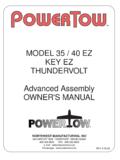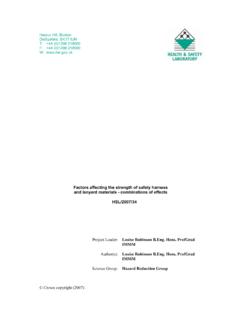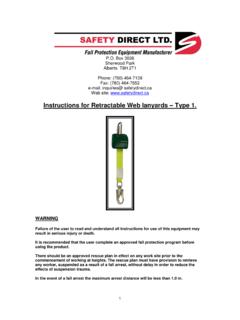Transcription of DONNING INSTRUCTIONS ABCs OF FALL …
1 DONNING INSTRUCTIONS abcs OF fall PROTECTION. Putting on a FallTech Full Body Harness: Personal fall Arrest Systems, as easy as A, B, C, D. 1. After inspecting the harness, grab the dorsal (back) D-ring and give the A point of attachment for lanyards, lifelines, and deceleration devices; also called a tie-off point. harness a shake while lifting harness up. This ensures harness strapping is Examples: rebar, I-beam, scaffold, roof truss not tangled. ANCHOR to enjoin a connecting device (SRL, lanyard) to the anchor point. Examples: sling anchor, grip anchor, wire form hook, beam clamp 2. Unfasten all buckles (mating and/or tongue buckle). Slip one arm through harness making sure dorsal D-ring is on your back. Slip your free arm through B BODY Full Body Harness worn by a person used to enjoin the body with the connecting device other side of harness and position straps on shoulders.
2 Chest strap will be in every personal fall arrest system. across your chest if positioned properly. Examples: vest style, crossover style, single D-ring up to 6 D-ring. 1. Full Body Harnesses should be chosen to compliment the work to be done with consideration to the work 3. Reach between legs and grab one leg strap. Bring strap up between legs and environment. connect mating or tongue buckle. Repeat for other leg strap. C piece of equipment used to enjoin components of all personal fall arrest systems. 4. Connect chest strap by attaching mating buckle closures. Ideal position for Examples: carabiner, snap hook, mating buckle, D-ring. your chest strap is about six (6) inches below your shoulders. Adjust waist belt (if included). CONNECTING component of the personal fall arrest system that couples the full body harness to the anchorage connector. 5. Adjust leg and chest straps to size.
3 If you can slip your three lead fingers Examples: lanyard, lifeline. between yourself and webbing, proper sizing has been achieved. D DECELERATION that slows and dissipates energy during a fall . 2. Examples: shock absorbing lanyard, self-retracting lifeline, rope grab. Only when all of the above components are assembled together, do you have a complete Personal fall Arrest Sys- tem (PFAS). Collectively, these are A, B, C, D. 3. 4. 5. PAGE I 54 PAGE I 55. SIZING CHARTS OSHA & ANSI STANDARDS. OSHA Regulations Under Title 29 of the Code of Federal Regulations OSHA Occupational Safety and Health Standards for General Industry Subpart D, Walking/Working Surfaces Fixed Ladder, Ladder Safety Devices (d) (5). Safety Requirements for Scaffolding, Boatswains Chair (j) (4). Full Body Harness Sizing Guide Subpart I, Personal fall Arrest Systems _____Proposed Subpart F, Powered Platforms and Building Maintenance Subpart J, Permit - Required Confined Space Subpart R, Special Industries Telecommunications Electric Power Generation, Transmission and Distribution OSHA Safety and Health Regulations for Construction Subpart E, Personal Protective Equipment Safety Belts, Lifelines and Lanyards Safety Nets Subpart L, Scaffolding fall Protection (g).
4 Subpart M, fall Protection Scope, Application and Definitions Duty to Have fall Protection fall Protection Systems Criteria and Practices Training Requirements Subpart R, Steel Erection fall Protection Body Belts Sizing Guide ANSI Standards Construction and Demolition Operations: Requirements for Safety Belts, Harnesses, Lanyards, Lifelines-Construction and Demolition Ladders - Fixed - Safety Requirements Safety Requirements for Confined Spaces Safety Requirements for Personal fall Arrest Systems, Subsystems and Components For more information on the above OSHA (Occupational Safety & Health Administration) or ANSI (American National Standards Institute) please visit their websites: or PAGE I 56 PAGE I 57.






